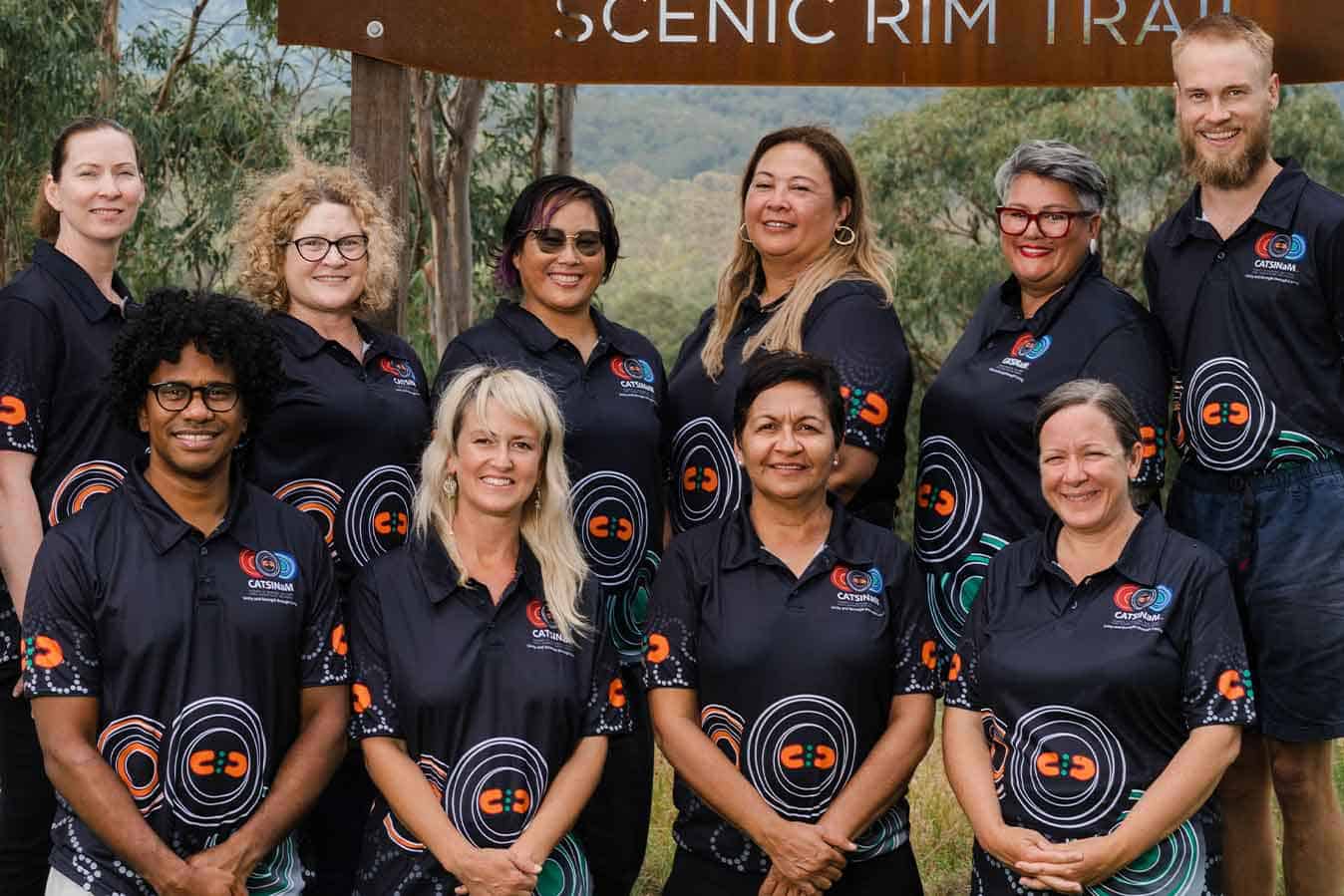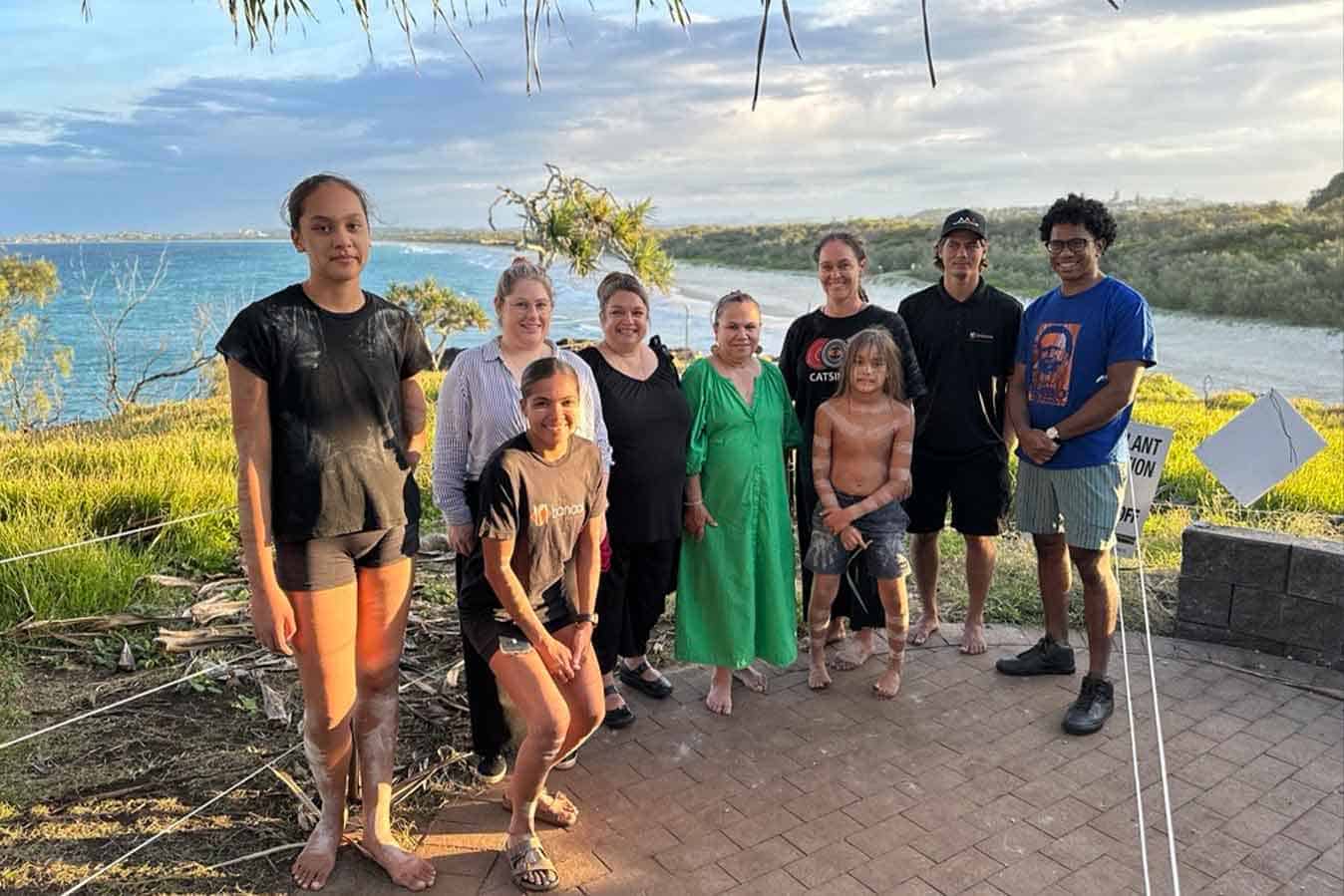Dr Ali Drummond, a Meriam, Erubam and Wuthathi man, followed the footsteps of his mother, a Torres Strait Islander health worker, to pursue a career in health and become a nurse.
Back in 2005, he was one of just three students to complete a Bachelor of Nursing degree in his hometown, at James Cook University’s remote Thursday Island (Waibene) campus.
That year, Dr Drummond was also the inaugural recipient of the James Cook University Sally Goold Award, named after the trailblazing Aboriginal nurse, recognising the Aboriginal and/or Torres Strait Islander student nurse graduate with the highest grade point average.
It is little surprise that nearly two decades on, the registered nurse, academic and health advocate has emerged to lead CATSINaM as Chief Executive Officer, a role he was appointed to in May this year.
Dr Drummond’s extensive nursing experience spans clinical practice, education, policy, academia and research. His posts have included orthopaedic nursing at Brisbane’s Princess Alexandra Hospital, Assistant Director of Nursing (Indigenous Nurse Advisor) to Queensland’s Chief Nursing and Midwifery Officer, where he oversaw a cadetship program for Aboriginal and Torres Strait Islander nursing and midwifery students, and Senior Lecturer at the Queensland University of Technology, where he taught into the nursing programs, as well as provided faculty leadership as a Director of Indigenous Health.

Front row (L-R): Ali Drummond, Anthea Burns, Bronwyn Bathern, Fiona Rowe-Minniss
In recent years, Dr Drummond has focused on Aboriginal and Torres Strait Islander health research, including his PhD exploring academics who teach Aboriginal and Torres Strait Islander health and cultural safety in undergraduate nursing programs.
Despite working across a broad range of areas, the ongoing challenge to improve the health and wellbeing of Aboriginal and Torres Strait Islander peoples, has always been front of mind, he says.
“My experience as a clinician in remote, as well as urban Australia and my experience in policy has really highlighted to me, the limitations of the health and education sectors,” Dr Drummond tells the ANMJ.
“Lots of initiatives tend to focus on individuals, or bad apples, when really, it is the systems that need reform; reform that’s led, or co-led, by Aboriginal and Torres Strait Islander people because we understand how the system doesn’t work for us.”
Dr Drummond’s lived experience as an Aboriginal and Torres Strait Islander nurse, coupled with research into understanding the many barriers, including racism and discrimination, that prevent Aboriginal and Torres Strait Islander people working in and accessing the health system, and equally, how to come up with new strategies and solutions, arms him with the broad experience and passion necessary to continue to position CATSINaM as the national voice for Aboriginal and Torres Strait Islander nurses and midwives.
“It comes with a lot of opportunities to put experience and ideas into action and to look at how we invest in legacy work from my predecessors, all the way back to the original architects of CATSIN, its previous name,” Dr Drummond says of the CEO role.
“That’s important work, because it’s that legacy work that must transcend generations of Aboriginal and Torres Strait Islander nurses and midwives, to remind ourselves, not just where we’ve come from, but the ongoing omnipresence of colonisation.”
“As an immature country, without a treaty, we’re left in a state where there’s a lot of unfinished business between Aboriginal and Torres Strait Islander and non-Indigenous peoples. CATSINaM members have never forgotten that, it hasn’t been far from our minds,” Dr Drummond adds.
“We continually need to push back on any reproduction of colonisation, push for greater recognition of Aboriginal and Torres Strait Islander nurses’ and midwives’ knowledge and way of doing things, and particularly how we can better inform the design of healthcare systems, including models of care that truly respond to the needs of Aboriginal and Torres Strait Islander communities.”
Since taking on the role as CEO, Dr Drummond says CATSINaM’s priorities have included ongoing work to grow and support the workforce and create more professional development opportunities for its members.
During its conference series last August, CATSINaM released the ‘gettin em n keepin em n growin em’ :Strategies for Aboriginal and Torres Strait Islander Nursing and Midwifery Education Reform (GENKE II). Essentially, the report responds to an examination of the failures to strategically implement the original ‘gettin em n keepin em’ report released in 2002.
For example, despite a decades-long goal of reaching representation parity, GENKE II found that the number of Aboriginal and Torres Strait Islander nurses and midwives in the Australian workforce is still significantly underrepresented. Inroads have been made in other areas, such as achieving the support of the nursing and midwifery leadership to build the capacity of the Australian health workforce to provide culturally safe health services to Aboriginal and Torres Strait Islander peoples, thereby contributing to the elimination of racism.
Importantly, the GENKE II report calls for a formal partnership between the Australian Nursing and Midwifery Accreditation Council (ANMAC), responsible for accreditation of nursing and midwifery tertiary programs, and CATSINaM, to co-design, co-produce, and co-accredit nursing and midwifery education relating to Aboriginal and Torres Strait Islander health. CATSINaM is also seeking a partnership agreement with the Nursing and Midwifery Board of Australia (NMBA) to facilitate comprehensive reform.
Dr Drummond says actioning the recommendations of the GENKE II report is imperative.
“Our focus has been on implementation,” he says.
“GENKE II is a high-level document with a raft of national-level recommendations and extensive stakeholders, such as the NMBA and Council of Deans of Nursing and Midwifery.

“We’re not asking to be an advisory group to their decision-making; we’re actually asking to be active partners and participants in decision-making, as an equal holder of power at the decision-making table, for core business that relates to Aboriginal and Torres Strait Islander health and cultural safety.”
Meanwhile, CATSINaM has also turned its gaze upon creating more opportunities for its members to access professional development, including clinical education as well as governance and leadership.
“There are so many opportunities at the moment for increasing Aboriginal and Torres Strait Islander nurses and midwives in the workforce, including in specialty areas,” Dr Drummond says.
“We’re engaging with speciality areas to see what professional development opportunities they can provide our members, as collectively we benefit. They get Aboriginal and Torres Strait Islander people participating in their programs, or in their colleges, and our members benefit from professional development pathways that have been critiqued and informed by CATSINaM.”
Looking ahead, CATSINaM has this year changed tack in the way it intends to run its annual national conference. Instead of a usual capital city gala conference, this year, a regional conference will take place in Kingscliff, on Bundjalung country, with an intention to engage a more local and personalised presence for members and regional-based stakeholders.
“The intention is to get out into the regions, to engage with members who actually live and work in the regions, as well as Aboriginal Community Controlled Health Organisations (ACCHOs) who service those regions. The focus will be more on providing a program of high quality and engaging professional development experiences rather than traditional research presentations,” Dr Drummond says.
Another important project for CATSINaM involves building on its national exhibition launched last year, ‘In Our Own Right: Black Australian Nurses and Midwives Stories’, which showcased the journeys of trailblazing Aboriginal and Torres Strait Islander nurses and midwives from the 1950s to the present.
The exhibition included photographs, artworks, and audio and video of 75 Aboriginal and Torres Strait Islander nurses and midwives, with CATSINaM now hoping to take it on the road and share it to a wider audience, potentially the short-film circuit.

“In a time when we’re talking about Aboriginal and Torres Strait Islander voices and a Voice to Parliament, we’ve got to make sure that people understand the value of Aboriginal and Torres Strait Islander peoples’ voices in general and what a great way to honour the voices of all these great nurses and midwives who have come before us.”
“What I’ve learned from the In Our Own Right national exhibition is the complexity of the understanding and practice of caring, from an Aboriginal and Torres Strait Islander nurses and midwives perspective,” Dr Drummond adds.
“There is this staunchness to the way in which we understand and practice care. Our compassion is strengthened by our advocacy against things that clearly don’t work for our patients and their families and communities.”
As the peak body for Aboriginal and Torres Strait Islander nurses and midwives, CATSINaM ultimately remains focused on leading the nursing and midwifery workforce to improve health outcomes for Aboriginal and Torres Strait Islander peoples.
Dr Drummond believes this goal demands alignment with the national Closing the Gap partnership and other key stakeholders to ensure CATSINaM is valued as a key partner in reform.
“We’re done with being the advisor, we actually want to be given legitimate power and decision-making when it comes to working together,” he says.
“We want to see more investment in CATSINaM and other Community Controlled Organisations, including Aboriginal and Torres Strait Islander health services, so that when we’re talking about issues like clinical placements, and rural and remote workforce, we’re partnering up and involved in decision-making, and in the implementation and evaluation work.”
“We want to be trusted to provide leadership when it comes to changing the ways in which government and other key institutions work with Aboriginal and Torres Strait Islander people. Closing the Gap must focus on systemic reform, and Aboriginal and Torres Strait Islander people are best to lead this work.”










